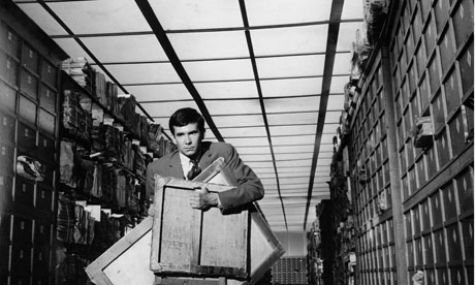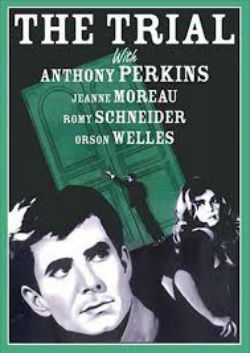 I think the chief accomplishment of Orson Welles’s The Trial is that it so fully traps us in its nightmare world. The movie is an adaptation of Kafka’s novel about a man named Josef K who wakes up one morning to find that he is being persecuted for some unknown offense. K stumbles from one bizarre confrontation with the law to another. He is never told what he's charged with, but he is assured that his case is going very badly. Welles’s film takes this surreal premise and runs with it.
I think the chief accomplishment of Orson Welles’s The Trial is that it so fully traps us in its nightmare world. The movie is an adaptation of Kafka’s novel about a man named Josef K who wakes up one morning to find that he is being persecuted for some unknown offense. K stumbles from one bizarre confrontation with the law to another. He is never told what he's charged with, but he is assured that his case is going very badly. Welles’s film takes this surreal premise and runs with it.
The movie was made during Welles’s second European exile. After the failed release of Touch Of Evil in 1958, the director had more or less washed his hands of Hollywood. He would spend much of the 60s in Europe, a period in which he made some of his best work: The Trial, Falstaff (Chimes At Midnight), and The Immortal Story. Not only are all these films fascinating, they also comprise a pretty good run of luck for a director who had so often had to struggle with producers and studios to get his vision on screen.
The primary pleasure of an Orson Welles movie is the visual texture the director creates. The Trial is, in some ways, the best example of this in his entire body of work. Nearly every shot in this movie is rich, layered, and interesting on its own merits. As a director, Welles was often accused of stylistic excess, but because The Trial unfolds with “the logic of a dream,” Welles’s stylistic depth is wholly appropriate. He creates a world that closes in on Josef K (Anthony Perkins) one scene at a time. Welles, who was never a realist, here makes his most expressionistic film. It was one of the few times in his post-Citizen Kane career where he had the freedom to achieve his vision how he saw fit.
 And what a vision it is: shot largely in and around the Gare d’Orsay (which at the time was just an abandoned train station in Paris), the architecture is constantly pressing in on Anthony Perkins, yet the film is full of huge spaces. Welles makes an epic out of these caverns. The camera is forever angled so as to make the ceilings press down. Angles are sharpened like knives, and the film is full of sightlines of slanting symmetrical perfection. When K goes to work, it is at an office straight out of Vidor’s The Crowd, with desks and florescent lights, perfectly aligned, stretching off into infinity. Even in scenes shot outside, Welles uses plain building facades with long lines of bare windows. Juxtaposed against this tight Brutalist control are scenes of maddening surrealism, where everything in this nighttime world is increasingly arbitrary. K enters narrow corridors of an empty building only to find hundreds of spectators crammed into a massive hall waiting for his trial. A small door on one side turns into a massive door on the other side. K visits an artist who lives up a flight of stairs in a wooden nest swarmed over by screaming pubescent girls, but when he escapes the horde by slipping through a hole in the nest, it somehow leads into an underground tunnel. K is like a man caught inside a machine about to crush him to pieces, but the machine itself makes about as much sense as a Rube Goldberg contraption.
And what a vision it is: shot largely in and around the Gare d’Orsay (which at the time was just an abandoned train station in Paris), the architecture is constantly pressing in on Anthony Perkins, yet the film is full of huge spaces. Welles makes an epic out of these caverns. The camera is forever angled so as to make the ceilings press down. Angles are sharpened like knives, and the film is full of sightlines of slanting symmetrical perfection. When K goes to work, it is at an office straight out of Vidor’s The Crowd, with desks and florescent lights, perfectly aligned, stretching off into infinity. Even in scenes shot outside, Welles uses plain building facades with long lines of bare windows. Juxtaposed against this tight Brutalist control are scenes of maddening surrealism, where everything in this nighttime world is increasingly arbitrary. K enters narrow corridors of an empty building only to find hundreds of spectators crammed into a massive hall waiting for his trial. A small door on one side turns into a massive door on the other side. K visits an artist who lives up a flight of stairs in a wooden nest swarmed over by screaming pubescent girls, but when he escapes the horde by slipping through a hole in the nest, it somehow leads into an underground tunnel. K is like a man caught inside a machine about to crush him to pieces, but the machine itself makes about as much sense as a Rube Goldberg contraption.
The Trial is wonderfully, gloriously, unlike most movies. The entire affair is lifted beyond what we’re used to seeing onscreen because Welles’s ambition is to give us a dreamlike world—a nightmare we can’t see through. He succeeds in this respect—the movie doesn’t seem placed in our world. It almost seems to have been shot on a gigantic studio set. I say almost because although it is every bit as strange as The Night of the Hunter it doesn’t have a studio look, and it doesn’t feel artificial. It seems real but not real. Sort of like a dream. That it was shot without many sets at all and still achieves its otherworldly quality is a testament to Jean Ledrut's creepy score and Welles’s ability to brilliantly utilize the Gare d’Orsay for a variety of effects.
Interestingly, Welles rewrites Kafka’s story in two important ways, both of which make the film more distinctly Wellesian. First, he sees Joseph K not as an innocent man but as a guilty man. Although we’re never told what crime he has supposedly committed, K comes across like someone guarding a nasty secret. Anthony Perkins is a perfect choice to play this take on K because, of the Method actors who emerged in the 1950s, he was the most ill-at-ease. He never seems comfortable in his own skin. Jittery, stuttering, and oddly funny, he makes K a maladroit constantly being thwarted in his desire to sort things out logically. The second major change Welles made was to the climax of the story. Whereas Kafka had K submit meekly to execution, Welles has him remain angrily defiant to the end. (Welles explained that, after the Holocaust, he could not have his protagonist submissively acquiesce to his own slaughter.) The effect of these two changes is fascinating. Instead of an innocent man who goes sheepishly to his doom, K becomes a guilty man furiously decrying his fate. The arbitrary nature of the state, and the cruel indifference of its judicial arm, remain the same, but Welles gives us a protagonist who has more in common with one of his noir antiheroes than a Kafka character.
Of course, The Trial is one of those Orson Welles movies, like Citizen Kane or F For Fake, which is pretty much a genre of one. It’s part drama, part horror movie, part comedy, part fantasia. Visually, of course, it is every bit the film noir. Its story is also noirish in the sense that it deals with guilt, fear, and the gnawing suspicion that life is meaningless. Yet, the film has a distinctly abstract, metaphorical quality (as does Kafka’s novel) that would set it apart from most film noirs. It is an art film with a distinctly European flair, and it emanates from the same dark corner of the mind that produced something like the Expressionistic proto-noir The Stranger On The Third Floor, but at the end of the day, it is best thought of as an Orson Welles movie. No other label really fits.
No matter what label you attach to it, The Trial is one of the director’s great achievements. It should not be missed.
Jake Hinkson is the author of several books, including the novel The Big Ugly, the newly-released short story collection The Deepening Shade, and the essay collection The Blind Alley: Exploring Film Noir's Forgotten Corners.
Read all of Jake Hinkson's posts for Criminal Element.

Postscript: Welles planned to do an essay film on the making of THE TRIAL. It never came about, but he shot footage of a Q&A session he did with film students. [url=https://www.youtube.com/watch?v=n8BR034qDsk]Check it out here[/url].
K isn’t innocent in Kafka. He may know – or tell himself – he had done nothing wrong, but that isn’t necessarily true. In fact, it’s “a world where guilt consists in being alive at all.”